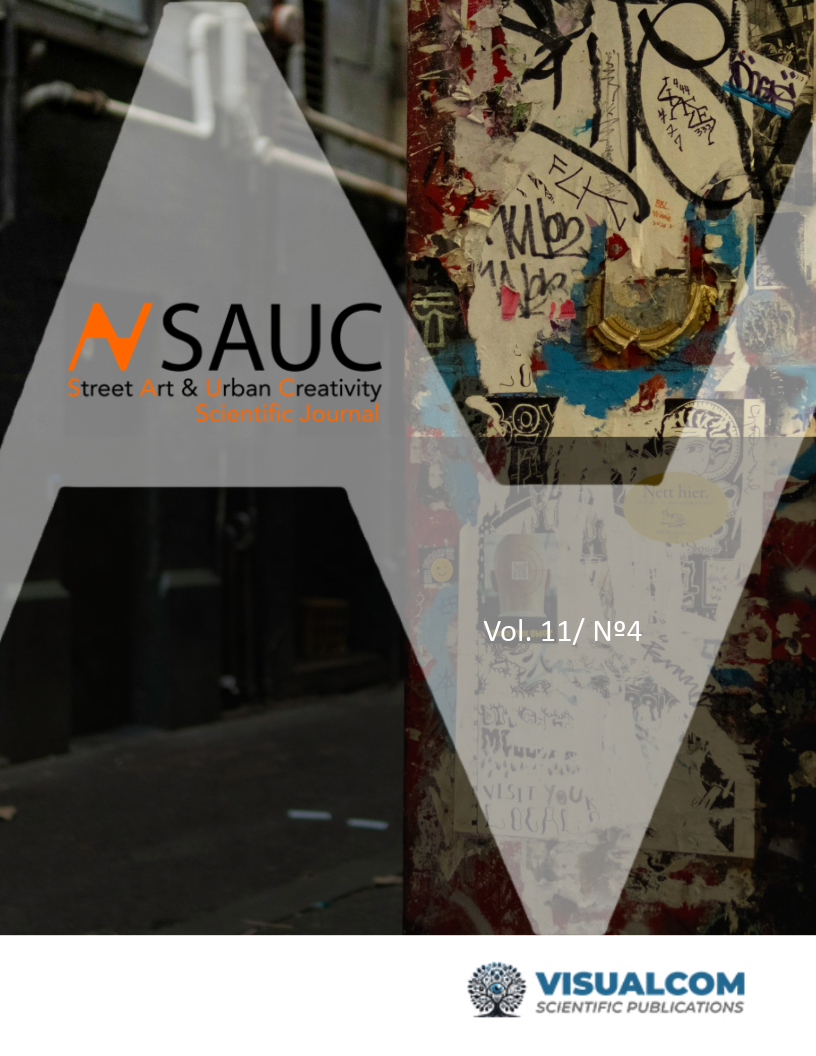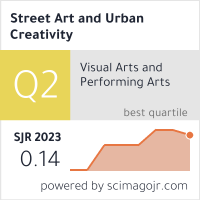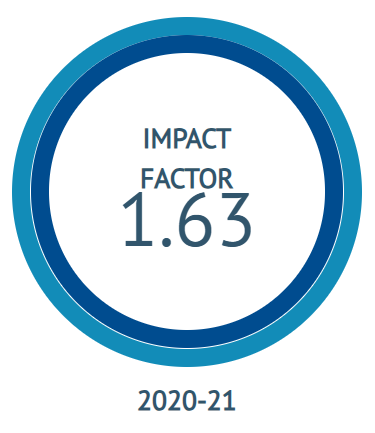Artificial Intelligence Applied to the Analysis of Hate Speech
Trump´s and Biden During the Capitol Attack in Washington D.C.
DOI:
https://doi.org/10.62161/sauc.v11.5813Keywords:
Politics, Capitol Storming, Hate, Histogram, Artificial Intelligence, Trump, BidenAbstract
In January 2021, during a rally in Washington, D.C., Donald Trump claimed electoral fraud and urged citizens to go to the Capitol. Hours later, dozens stormed the building, leaving four dead and 52 arrested. Afterwards, both Joe Biden and Trump released audiovisual messages. This study uses AI tools to qualitatively analyse those speeches via the ONEIA application. A quantitative analysis with OpenAI also assessed the videos' aesthetic treatment. Despite major content differences in the speeches, the audiovisual style showed high similarity, supported by statistical analysis of frame histograms.
Downloads
Global Statistics ℹ️
|
293
Views
|
220
Downloads
|
|
513
Total
|
|
References
Abrar, M., Jabeen, S. and Abbas. S. (2021). Socio-Economic Effects of Customer Knowledge, Political Support, and Innovation on the Growth of Islamic Banking System; Case Study of Pakistan. Research Square, 22. https://doi.org/10.21203/rs.3.rs-311357/v1
Acharya, T. and Ray, A. K. (2005). Image Processing: Principles and Applications. New York: Wiley-Interscience, (pp. 36-37). https://doi.org/10.1002/0471745790.ch2
Adam, A., Rivlin, E. and Shimshoni, I. (2006). Robust Fragments-based Tracking using the Integral Histogram, IEEE Computer Society Conference on Computer Vision and Pattern Recognition (CVPR'06), New York, NY, USA, pp. 798-805, https://doi.org/10.1109/CVPR.2006.256
Alatawi, H. S., Alhothali, A. M., & Moria, K. M. (2021). Detecting white supremacist hate speech using domain specific word embedding with deep learning and BERT. IEEE Access, 9, 106363-106374. https://ieeexplore.ieee.org/document/9497095/
Angulo, J. and Serra, J. (2005). Segmentación de Imágenes en Color utilizando Histogramas Bi–Variables en Espacios Color Polares Luminancia/Saturación/Matiz. Computación y Sistemas, 8(4).
Atkinson, G. (2014). Shear rate normalization is not essential for removing the dependency of flow-mediated dilation on baseline artery diameter: past research revisited. Physiological Measurement, 35(9), 1825–1835. https://doi.org/10.1088/0967-3334/35/9/1825
Badjatiya, P., Gupta, S., Gupta, M., & Varma, V. (2017). Deep learning for hate speech detection in tweets. In Proceedings of the 26th international conference on World Wide Web companion (pp. 759-760).
Barrientos, A., Caldevila, D. and Vargas, J. J. (2019). El protocolo, la puesta en escena y la persuasión en los debates políticos televisados. Revista de Marketing Aplicado, 23(3), 17-27. https://doi.org/10.17979/redma.2019.23.3.5872
Behar Guitiérrez, R. and Grima i Cintas, P. (2013). El histograma como un instrumento para la comprensión de las funciones de densidad de probabilidad. Probabilidad Condicionada: Revista de didáctica de la Estadística, 2, 229-235. http://hdl.handle.net/2117/19754
Benjamin, W. (2008). The work of art in the age of mechanical reproduction (J. A. Underwood, Trad.). Harlow, Inglaterra: Penguin Books.
Benoit, W. L., Hansen, G. J. and Verser, Rebecca M. (2003). A meta-analysis of the effects of viewing U.S. presidential debates. Communication Monographs, 70(4), 335-350. https://doi.org/10.1080/0363775032000179133
Bhattacharya, A., Chakrabarti, T., Basu, S., Knott, A., Pedreschi, D., Chatila, R., ... & Biecek, P. (2024). Towards a crowdsourced framework for online hate speech moderation-a case study in the Indian political scenario. In Companion Publication of the 16th ACM Web Science Conference (pp. 75-84). https://doi.org/10.1145/3630744.3663607
Bunde, E. (2021). AI-assisted and explainable hate speech detection for social media moderators – A design science approach. Proceedings of the 2021 Annual Hawaii International Conference on System Sciences (HICSS) (pp. 1264–1274). https://doi.org/10.24251/HICSS.2021.154
Cerdán Martínez, V., & Padilla Castillo, G. (2019). Historia del «fake» audiovisual: «deepfake» y la mujer en un imaginario falsificado y perverso. Historia y comunicacion social, 24(2), 505–520. https://doi.org/10.5209/hics.66293
Chace, S. (2021). “Unlocking Us”: Analyzing the US election and its aftermath. Leadership (London), 17(3), 365–375. https://doi.org/10.1177/17427150211003002
Chao, A. F., Wang, C. S., Li, B. Y., & Chen, H. Y. (2024). From Hate to Harmony: Leveraging Large Language Models for Safer Speech in Times of COVID-19 Crisis. Heliyon. https://doi.org/10.1016/j.heliyon.2024.e35468
Chen, H., Li, C., Zheng, L., Lu, W., Li, W. and Wei, W. (2021). A machine learning‐based survival prediction model of high grade glioma by integration of clinical and dose‐volume histogram parameters, Cancer Medicine, 10(8), 2774-2786. https://doi.org/10.1002/cam4.3838
Coltuc, D., Bolon, P. and Chassery, J. (2006). Exact histogram specification. IEEE Transactions on Image Processing, 15(5), 1143-1152. https://doi.org/10.1109/TIP.2005.864170
Dou, W., Ren, Y., Chen, Y., Ruan, S., Bloyet, D. and Constrans, J. M. (2005). Histogram-based generation method of membership function for extracting features of brain tissues on MRI images. L. Wang, Y. Jin (Eds.), FSKD, LNAI, 3613, Springer-Verlag, Berlin (pp. 189-194).
Durschlag, J. (2021, enero 8). Trump calls for healing, smooth transition after «heinous attack» on Capitol. Fox News. https://www.foxnews.com/us/trump-calls-for-healing-smooth-transition-after-heinous-attack-on-capitol
Fell, G., Redd, R. A., Vanderbeek, A. M., Rahman, R., Louv, B., McDunn, J., Arfè, A., Alexander, B. M., Ventz, S., & Trippa, L. (2021). KMDATA: a curated database of reconstructed individual patient-level data from 153 oncology clinical trials. Database: The Journal of Biological Databases and Curation, 2021. https://doi.org/10.1093/database/baab037
Fenza, G., Loia, V., Stanzione, C., & Di Gisi, M. (2024). Robustness of models addressing Information Disorder: A comprehensive review and benchmarking study. Neurocomputing, 127951. https://doi.org/10.1016/j.neucom.2024.127951
Flores, M. J., Robayo Jácome, D. J. and Saa Escobar, D. A. (2015). Histograma del gradiente con múltiples orientaciones (hog-mo) detección de personas. Investigación y Desarrollo, 12, 2(5). https://doi.org/10.14483/2322939X.10991
Fuchs, C. (2021). How Did Donald Trump incite a coup attempt? tripleC Communication Capitalism & Critique Open Access Journal for a Global Sustainable Information Society, 19(1), 246–251. https://doi.org/10.31269/triplec.v19i1.1239
Galfione, M. V. (2014). Estética y política: el debate contemporáneo en torno a las formas de la representación. Trans/Form/Ação, 37(1), 223–246. https://doi.org/10.1590/S0101-31732014000100012
Gandhi, A., Ahir, P., Adhvaryu, K., Shah, P., Lohiya, R., Cambria, E., Poria, S., & Hussain, A. (2024). Hate speechdetection: A comprehensive review of recent works. Expert Systems, 41(8), e13562. https://doi.org/10.1111/exsy.1356224
Géraud, T., Strub, P. Y. and Darbon J. (2001). Color image segmentation, Proc. of IEEE International Conference on lmage Processing (ICIP'01), IEEE, 3, 70–73.
Glasbey, C. A. (1993). An Analysis of Histogram-Based Thresholding Algorithms. CVGIP: Graphical Models and Image Processing, 55(6), 532-537. https://doi.org/10.1006/cgip.1993.1040
Gongane, V. U., Munot, M. V., & Anuse, A. D. (2022). Detection and moderation of detrimental content on social media platforms: current status and future directions. Social Network Analysis and Mining, 12(1), 129. https://doi.org/10.1007/s13278-022-00951-3
Gongane, V. U., Munot, M. V., & Anuse, A. D. (2024). A survey of explainable ai techniques for detection of fake news and hate speech on social media platforms. Journal of Computational Social Science, 7, 1-37. https://doi.org/10.1007/s42001-024-00248-9
Grover, P., Kumar, A., Gupta, S. & Modgil, S. (2021). Influence of political leaders on sustainable development goals – insights from twitter. Journal of Enterprise Information Management, 34(6), 1893-1916. https://doi.org/10.1108/JEIM-07-2020-0304
Hallin, D. C. and Mancini, P. (2004). Americanization, globalization, and secularization: understanding the convergence of media systems and political communication. En F. Esser y B. Pfet- sch (eds.), Comparing Political Communication. Theories, Cases, and Challenges (pp. 25-44). Nueva York: Cambridge University Press.
Hemphill, M. (1996). A note on adults’ color-emotion associations. The Journal of Genetic Psychology, 157(3), 275–280. https://doi.org/10.1080/00221325.1996.9914865
Hossain, M. S., & Muhammad, G. (2019). Emotion recognition using deep learning approach from audio–visual emotional big data. Information Fusion, 49, 69-78 https://doi.org/10.1016/j.inffus.2018.09.008
Karmakar, D., Sarkar, R. & Datta, M. (2021). Colour band fusion and region enhancement of spectral image using multivariate histogram, International Journal of Image and Data Fusion, 12, 64-82. https://doi.org/10.1080/19479832.2020.1870578
Karni, A. (2021, enero 11). On the way out, Melania trump denounces attacks on her as “shameful”. The New York Times. https://www.nytimes.com/2021/01/11/us/politics/melania-trump-statement-capitol-riot.html
Khan, W. Z., Kibriya, H., & Siddiqa, A. (2024). Towards Safer Online Communities: Deep Learning and Explainable Ai for Hate Speech Detection and Classification. Computers and Electrical Engineering, 116, 109153. https://doi.org/10.1016/j.compeleceng.2024.109153
Koeing, B., Lacey, D., & Richards, G., (2012). Video frame comparisons in digital video authenticity analyses. Journal of Forensic IdentificationVolume 62(2), 165 – 182.
Kumar, K., Birla, L. & Rao, S. K. (2018). A robust unsupervised pattern discovery and clustering of speech signals. Pattern Recognition Letters, 116, 254-261. https://doi.org/10.1016/j.patrec.2018.10.035
Kumar, P., Malik, S., & Raman, B. (2024). Interpretable multimodal emotion recognition using hybrid fusion of speech and image data. Multimedia Tools and Applications, 83(10), 28373-28394. https://doi.org/10.1007/s11042-023-16443-1
Kurugollu, F., Sankur, B. & Harmanci, A. (2001). Color image segmentation using histogram multithresholding and fusion, Image and Vison Computing, 19(13), 915–928. https://doi.org/10.1016/S0262-8856(01)00052-X
Lee, E., Rustam, F., Washington, P. B., El Barakaz, F., Aljedaani, W., & Ashraf, I. (2022). https://doi.org/10.1016/S0262-8856(01)00052-X el. IEEE Access, 10, 9717-9728.
Leekha, R., Simek, O., & Dagli, C. (2024). War of Words: Harnessing the Potential of Large Language Models and Retrieval Augmented Generation to Classify, Counter and Diffuse Hate Speech. In The International FLAIRS Conference Proceedings (Vol. 37). https://doi.org/10.32473/flairs.37.1.135484
Leslie, E. (2019). Anti-fascism, anti-art, doubt and despair. Third Text, 33(3), 293–313. https://doi.org/10.1080/09528822.2019.1627053
Lu, D., Li., Y., L., H. & Pillai, J. J. (2021). Histogram-based analysis of cerebral blood flow using arterial spin labeling MRI in de novo brain gliomas: relationship to histopathologic grade and molecular markers, Functional Neuroradiology, 63, 751-760. https://doi.org/10.1007/s00234-020-02625-3
Mangan, D., & Breuninger, K. (2021, enero 21). Trump hires impeachment lawyer, McConnell wants Senate trial in February for Capitol riot incitement charge. CNBC. https://www.cnbc.com/2021/01/21/trump-not-prepared-for-senate-impeachment-trial-for-capitol-riots.html
Matthews, D. (2021, enero 6). A Trump supporter called C-SPAN in tears to ask if her president had lied to her. Vox.
Meier, B. P., Robinson, M. D., Crawford, L. E., & Ahlvers, W. J. (2007). When «light» and «dark» thoughts become light and dark responses: affect biases brightness judgments. Emotion (Washington, D.C.), 7(2), 366–376. https://doi.org/10.1037/1528-3542.7.2.366
Modha, S., Majumder, P., Mandl, T., & Mandalia, C. (2020). Detecting and visualizing hate speech in social media: A cyber watchdog for surveillance. Expert Systems with Applications, 161, 113725 https://doi.org/10.1016/j.eswa.2020.113725
Morris, D. S. (2017). Twitter Versus the Traditional Media: A Survey Experiment Comparing Public Perceptions of Campaign Messages in the 2016 U.S. Presidential Election. Social Science Computer Review, 36(4). https://doi.org/10.1177/0894439317721441
Mozafari, M., Farahbakhsh, R., & Crespi, N. (2020). Hate speech detection and racial bias mitigation in social media based on BERT model. PloS one, 15(8), e0237861. https://doi.org/10.1371/journal.pone.0237861
Oliveira, A. S., Cecote, T. C., Silva, P. H., Gertrudes, J. C., Freitas, V. L., & Luz, E. J. (2023). How Good Is ChatGPT For Detecting Hate Speech In Portuguese?. En Anais do XIV Simpósio Brasileiro de Tecnologia da Informação e da Linguagem Humana (pp. 94-103). SBC.
Padilla Castillo, G. (2014). La espectacularización del debate electoral: estudio del caso en Estados Unidos. Vivat Academia, (132), 162-180. https://doi.org/10.15178/va.2015.132.162-180
Palakodety, S., KhudaBukhsh, A. R., & Carbonell, J. G. (2020). Voice for the voiceless: Active sampling to detect comments supporting the rohingyas. In Proceedings of the AAAI conference on artificial intelligence 34(1), 454-462. https://doi.org/10.1609/aaai.v34i01.5382
Place, J. A. & Peterson, L. S. (1974). Some visual motifs on film noir. Film Comment, 10(1), 30-35.
Plasser, F. & Plasser, G. (2002). La campaña global. Los nuevos gurúes del marketing político en acción. Buenos Aires: Temas Grupo Editorial.
Qin, K., Xu, K., Liu, F. & Li, D. (2011). Image segmentation based on histogram analysis utilizing the cloud model. Computers & Mathematics with Applications, 62(7), 2824-2833. https://doi.org/10.1016/j.camwa.2011.07.048
Rai, S. M. (2017). Performance and politics: an approach to symbolic representation. Politics, Groups & Identities, 5(3), 506–511. https://doi.org/10.1080/21565503.2017.1321996
Rasmussen, M. B. (2021). The aestheticisation of late capitalist fascism: Notes for a communist art theory. Third Text, 35(3), 341–354. https://doi.org/10.1080/09528822.2021.1916268
Russ, J. C. (2002). The Image Processing Handbook (pp. 58-60). Washginton: CRC Press.
Saleh, H., Alhothali, A., & Moria, K. (2023). Detection of hate speech using bert and hate speech word embedding with deep model. Applied Artificial Intelligence, 37(1), 2166719. https://doi.org/10.1080/08839514.2023.2166719
Sharma, I., Jain, K., Behl, A., Baabdullah, A., Giannakis, M., & Dwivedi, Y. (2023). Examining the motivations of sharing political deepfake videos: the role of political brand hate and moral consciousness. Internet Research, 33(5), 1727-1749. https://doi.org/10.1108/INTR-07-2022-0563
Simon, S. (2021). Trump’s insurrection and America’s year of living dangerously. Survival, 63(1), 7–16. https://doi.org/10.1080/00396338.2021.1881247
Sullivan, K., & Bradner, E. (2021, enero 6). Joe Biden calls on Trump to «end this siege». CNN. Recuperado de https://edition.cnn.com/videos/politics/2021/01/06/biden-responds-pro-trump-capitol-washington-dc-congress-electoral-college-vpx.cnn
Téllez, N., Muñiz, C. & Ramírez, J. (2010). Función discursiva en los debates televisados. Un estudio transcultural de los debates políticos en México, España y Estados Unidos. Palabra clave, 13(2), 251-270.
Thiago, D. O., Marcelo, A. D., & Gomes, A. (2021). Fighting hate speech, silencing drag queens? artificial intelligence in content moderation and risks to lgbtq voices online. Sexuality & culture, 25(2), 700-732. https://doi.org/10.1007/s12119-020-09790-w
Vafeiadis, M., & Shen, F. (2021). Effects of narratives, frames, and involvement on health message effectiveness. Health Marketing Quarterly, 39(3), 213-229. https://doi.org/10.1080/07359683.2021.1965824
Valdez-Zepeda, A. & Huerta-Franco, D. (2009). Estrategias de comunicación en campañas electorales: El caso de la contienda presidencial de Estados Unidos 2008. Contratexto, 17, 21-32. https://doi.org/10.26439/contratexto2009.n017.792
Villa-Gracia, D., & Cerdán, V. (2020). Evolución de la popularidad de Donald Trump y otros mandatarios internacionales en Google Trends (2016-2019). El profesional de la información, 29(1). https://doi.org/10.3145/epi.2020.ene.12
Walter, D. & Hellström, J. (2021). Government termination in Europe: a sensitivity analysis. West European Politics, 45(3), 591-611. https://doi.org/10.1080/01402382.2021.1880720
Zhao, J., Li, Z.-T. & Feng, B. (2015). A novel two-dimensional histogram modification for reversible data embedding into stereo H.264 video. Multimedia Tools and Applications, 75(10), 5959–5980. https://doi.org/10.1007/s11042-015-2558-9
Zhu, Y., Zhang, P., Haq, E. U., Hui, P., & Tyson, G. (2023). Can chatgpt reproduce human-generated labels? a study of social computing tasks. arXiv preprint arXiv:2304.10145. https://doi.org/10.48550/arXiv.2304.10145
Downloads
Published
How to Cite
Issue
Section
License
Copyright (c) 2025 Authors retain copyright and transfer to the journal the right of first publication and publishing rights

This work is licensed under a Creative Commons Attribution-NoDerivatives 4.0 International License.
Those authors who publish in this journal accept the following terms:
-
Authors retain copyright.
-
Authors transfer to the journal the right of first publication. The journal also owns the publishing rights.
-
All published contents are governed by an Attribution-NoDerivatives 4.0 International License.
Access the informative version and legal text of the license. By virtue of this, third parties are allowed to use what is published as long as they mention the authorship of the work and the first publication in this journal. If you transform the material, you may not distribute the modified work. -
Authors may make other independent and additional contractual arrangements for non-exclusive distribution of the version of the article published in this journal (e.g., inclusion in an institutional repository or publication in a book) as long as they clearly indicate that the work was first published in this journal.
- Authors are allowed and recommended to publish their work on the Internet (for example on institutional and personal websites), following the publication of, and referencing the journal, as this could lead to constructive exchanges and a more extensive and quick circulation of published works (see The Effect of Open Access).













